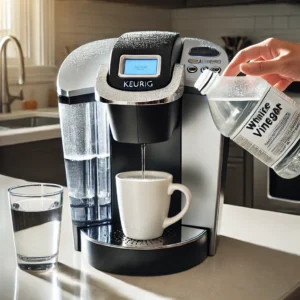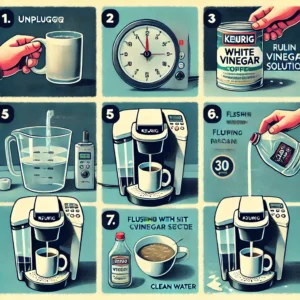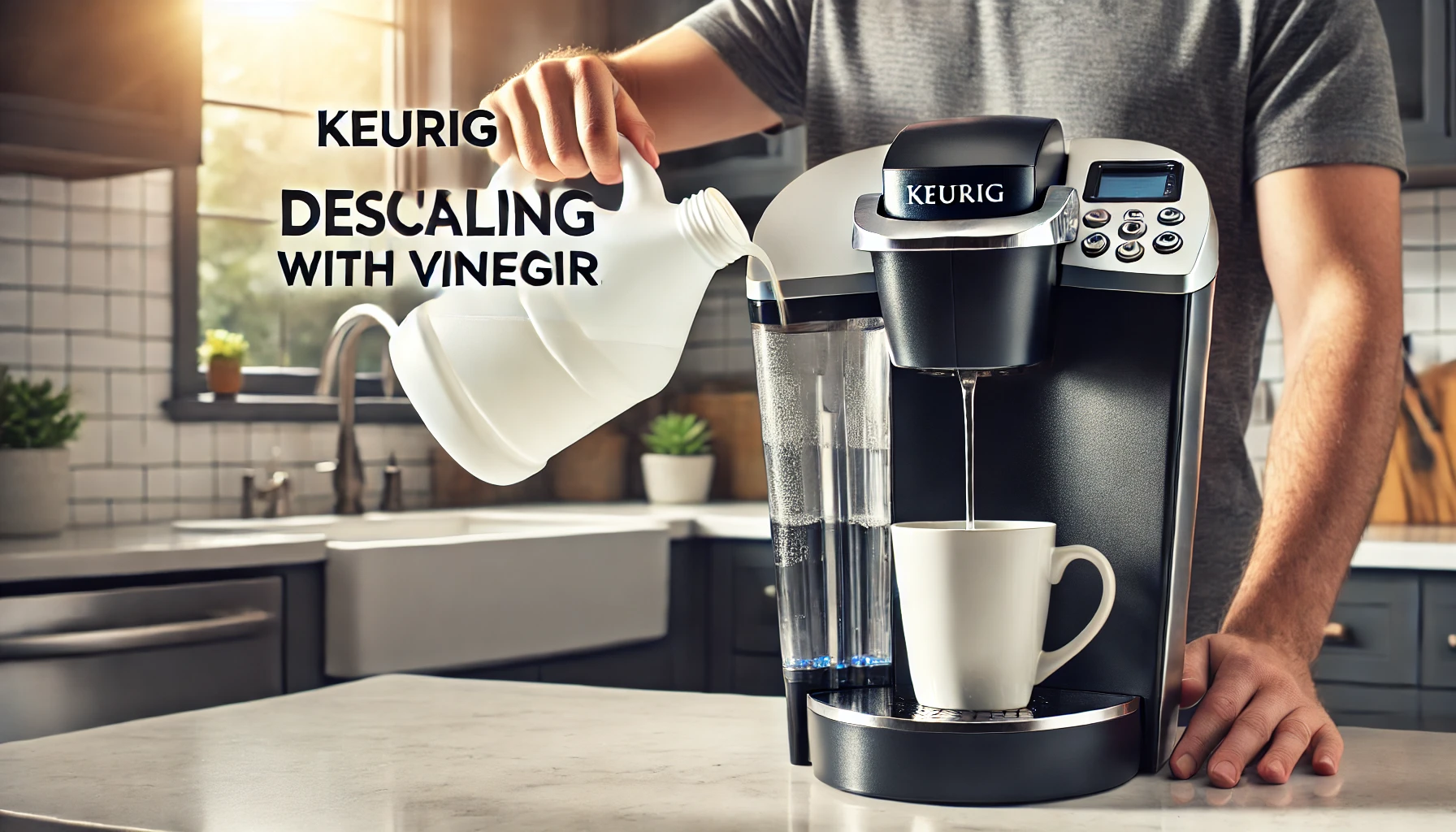Over time, calcium and other minerals from water accumulate in your Keurig Descaling with Vinegar, clogging the system and affecting both brewing performance and coffee flavor. The good news? There’s an easy, natural, and cost-effective solution Keurig descaling with vinegar.
In this guide, we’ll walk you through why descaling is essential, the benefits of using white vinegar, and a step-by-step process to bring your machine back to life. Whether you own a Keurig K-Slim, K-Express, or K-Elite, this method works across all models.
Why Descaling Your Keurig is Essential
Understanding Mineral Buildup
Every time you brew a cup of coffee, water passes through your Keurig. If you’re using tap water or even some bottled water, it likely contains minerals like calcium and magnesium. These minerals don’t just disappear—they slowly deposit inside your Keurig, forming scale buildup.
At first, you might not notice anything. But over time, you may experience:
- Slower brewing times
- Inconsistent coffee temperature
- Weaker or off-tasting coffee
- Water not flowing properly through the machine
Ignoring this issue for too long can even cause permanent damage to your Keurig’s brewing system.
Impact on Coffee Taste and Machine Performance
Ever noticed your coffee tasting slightly bitter or “off” lately? That’s often due to scale buildup interfering with proper brewing temperatures.
Keurigs are designed to heat water to an optimal range for coffee extraction. When mineral deposits clog the system, the machine struggles to reach the right temperature, leading to under-extracted, weak coffee.
Additionally, if scale blocks the needle or internal water lines, your Keurig might start sputtering, brewing less coffee than expected—or, in the worst-case scenario, stop working entirely.
Advantages of Using Vinegar for Descaling
Natural and Cost-Effective Solution
You could buy a Keurig descaling solution, but why spend extra when you already have white vinegar at home?
Vinegar is:
- Affordable – A fraction of the cost of commercial descaling solutions
- Effective – Dissolves mineral buildup just as well as store-bought alternatives
- Non-toxic – No harsh chemicals, making it safe for your coffee maker
It’s a simple, budget-friendly way to keep your Keurig running smoothly without unnecessary expenses.
See more: How to Effectively Descale Your Magimix Coffee Machine?
Environmental Benefits
Beyond being gentle on your machine, vinegar is also eco-friendly. Many commercial descaling solutions contain synthetic chemicals that end up in wastewater. Vinegar, on the other hand, is biodegradable and safe for the environment.
Using it regularly means maintaining your Keurig without contributing to unnecessary waste or pollution.
Step-by-Step Guide to Keurig descaling with Vinegar

Now, let’s get to the fun part—cleaning your Keurig!
Materials Needed
Before you begin, make sure you have:
✅ White vinegar (distilled, not apple cider vinegar)
✅ Fresh water (for rinsing)
✅ A large mug
✅ A clean, dry cloth
Preparation Steps

- Turn off your Keurig and unplug it for safety.
- Remove the water reservoir and discard any leftover water.
- If your model has a water filter, take it out (you can replace it after descaling).
- Empty the drip tray to prevent overflow during the process.
Descaling Process
Now that you’ve prepped your Keurig, let’s get into the actual descaling process.
- Fill the Water Reservoir with Vinegar
- Pour white vinegar into the water tank until it’s about halfway full.
- If your Keurig is heavily scaled, use full-strength vinegar. For light maintenance, a 50/50 mix of vinegar and water works fine.
- Run a Cleansing Brew Cycle
- Place a large mug on the drip tray.
- Start a brew cycle without a K-Cup, allowing the vinegar to flow through the system.
- Discard the liquid and repeat the process until the reservoir is empty.
- Let the Vinegar Sit
- Once you’ve run a few cycles, turn off your Keurig and let it sit for 30 minutes.
- This gives the vinegar time to break down any remaining mineral deposits inside the machine.
- Flush with Fresh Water
- Empty the water reservoir and rinse it thoroughly.
- Fill it with clean water only and run multiple brew cycles to remove any vinegar taste.
- It usually takes 2-3 full reservoirs to completely flush out the vinegar.
How Often Should You Descale Your Keurig?
Descaling frequency depends on how often you use your Keurig and the type of water you use.
- Every 3 months – Recommended for most users.
- Every 2 months – If you use hard water (high in minerals).
- Every 6 weeks – For heavy coffee drinkers who brew multiple cups daily.
Using filtered or distilled water can help reduce mineral buildup, meaning you won’t need to descale as often.
Tips for Maintaining Your Keurig Between Descaling
Descaling is important, but regular maintenance will keep your Keurig in top shape longer.
1. Clean the Drip Tray and Pod Holder Weekly
Coffee residue and splashes can build up in these areas, leading to mold and bacteria growth. Remove them and wash with warm soapy water at least once a week.
2. Use Filtered Water
Hard water causes faster scale buildup. If possible, use a Keurig water filter or a basic water filter pitcher to reduce mineral content before brewing.
3. Remove and Clean the Needles
Sometimes, leftover coffee grounds get stuck in the entry and exit needles, causing slow brewing or incomplete cups. Use a paperclip or Keurig maintenance tool to clear out any blockages.
Alternatives to Vinegar for Descaling
While white vinegar is an excellent choice, it’s not the only option.
1. Keurig Descaling Solution
- Made specifically for Keurig machines.
- Removes mineral deposits without leaving a strong smell.
- More expensive than vinegar but effective.
2. Citric Acid Powder
- Mix 1 tablespoon of citric acid with 1 liter of water.
- Works like vinegar but has a milder odor.
- Great for those who dislike the lingering vinegar smell.
3. Lemon Juice
- Natural and smells better than vinegar.
- Takes more rinses to remove the citrus taste.
- Works well for light descaling.
Troubleshooting Common Descaling Issues
Even after descaling, some users still face issues like clogging, bad taste, or slow brewing. Here’s how to fix them.
1. Persistent Scale Deposits
- If your Keurig is still brewing slowly, run another vinegar cycle or try citric acid for deeper cleaning.
- Make sure you let the descaling solution sit for at least 30 minutes before rinsing.
2. Unpleasant Vinegar Taste
- Run extra clean water cycles until the vinegar smell disappears.
- Add a pinch of baking soda to neutralize acidity (then rinse again).
3. Keurig Not Pumping Water After Descaling
- Try priming the pump by filling the reservoir, lifting it slightly, and placing it back down.
- If the issue persists, check for air bubbles in the water line and try a few extra brew cycles.
Frequently Asked Questions
Can I Use Apple Cider Vinegar Instead of White Vinegar?
No, it’s not recommended. Apple cider vinegar contains more sugars and residues, which can leave behind unwanted buildup. Stick to distilled white vinegar for best results.
Is Descaling Necessary If I Use Bottled Water?
Yes! Even filtered and bottled water still contain minerals that contribute to scaling over time. Descaling is essential, no matter what type of water you use.
Can I Speed Up the Rinsing Process?
Yes! If you want to quickly remove vinegar taste, try brewing hot water with a few drops of lemon juice before switching back to regular water.
Conclusion
Regular descaling is key to keeping your Keurig running smoothly. White vinegar is a cheap, effective, and natural way to remove mineral buildup and extend your machine’s lifespan.
By following this simple step-by-step guide, you can ensure your Keurig brews great-tasting coffee every time—without slow performance or weird flavors.
I’m Jeff Olson, and I love coffee. In fact, I’m something of a professional about coffee. I own and operate coffeemachinenes.com, one of the web’s top resources for everything coffee-related. I’m also an avid home barista, and enjoy experimenting with different brewing methods and flavor profiles. When I’m not nerding out about all things coffee, you can find me playing guitar or spending time with my wife and kids.

